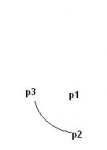I guess this is more a math question then a programming question but im firing it away anyway. 
What I want to do is getting a formula for finding out the degrees between 2 points in a circular arc..
Like for example, consider the attached image and its two points(p2,p3) and center point(p1) as part of a circular arc stretching 90 degrees. How do I calculate that if all I got is these three points. (which should be more then enough though I guess. hehe )
And will the calculation be different depending on where in the 'circle' the arc starts and end? I guess so?
The reason for this question is that I want to draw an arc using the .NET functions and it seems it only accept start degrees and sweeping degrees to draw the graphics instead of points in a circular arc.. Or am I wrong?
What I want to do is getting a formula for finding out the degrees between 2 points in a circular arc..
Like for example, consider the attached image and its two points(p2,p3) and center point(p1) as part of a circular arc stretching 90 degrees. How do I calculate that if all I got is these three points. (which should be more then enough though I guess. hehe )
And will the calculation be different depending on where in the 'circle' the arc starts and end? I guess so?
The reason for this question is that I want to draw an arc using the .NET functions and it seems it only accept start degrees and sweeping degrees to draw the graphics instead of points in a circular arc.. Or am I wrong?

